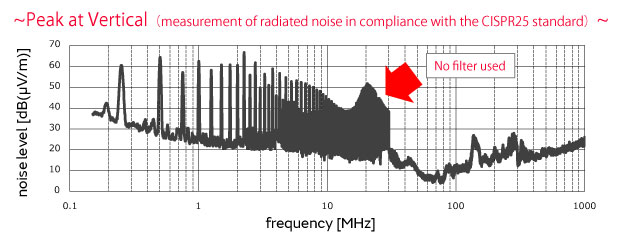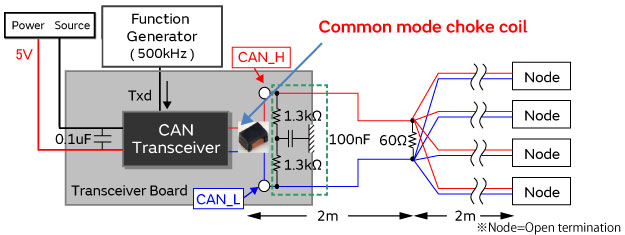Noise suppression technologies/case study introduction (Automotive)
For automotive LANs Suppression of noise in CANs using common mode choke coils (1)
【Background】
In recent years, the trend of electrification in the automotive market has been proceeding at a blistering pace. It is assumed that the number of electronic products featured in a vehicle will continue to increase as a result of the expansion and improvement of additional functions such as Advanced Driver Assistance Systems (ADAS). In this electrification of automobiles, automotive LANs for relaying information between the various electronic devices inside the car play an absolutely essential role. Automotive LANs must not only feature high speeds in order to pass along large volumes of information, they also need high levels of reliability in terms of the quality of the communication. Consequently, many interfaces tailored to these automotive devices are currently being used.
It is in this context that CANs (Controller Area Networks) are now becoming widely used as automotive LANs.
Suppression of noise in CANs
【Problems of electromagnetic noise in CANs and noise suppression components】
In CANs, high levels of reliability are required for the quality of communication, and it is so-called electromagnetic noise in particular that has an adverse effect on reliability. In resolving the problems of electromagnetic noise, it is necessary not only to suppress the generation of the noise so that it will not adversely affect the wireless communication, etc. used inside the automobile, but also to ensure high noise-resistance properties in order to maintain the communication quality even in the face of the noise that seeps in from the surroundings. For instance, in terms of radiated noise, harmonic noise with a signal frequency of 250 kHz (or 500 kHz) is radiated at high levels up to frequency bands of several dozen megahertz.

【Noise suppression results achieved by DLW series and evaluation of effects on waveforms】
In order to verify the effects achieved by the DLW43SH series in CANs, Murata has evaluated the radiated noise using a CAN evaluation board and also carried out BCI tests and waveform evaluations.
<Evaluation results>
■Radiated noise evaluation
It was verified that a noise suppression effect was achieved by adding the DLW43SH series.
For 250 kHz pulses, the noise suppression effect is approx. 25 dB at a 20.5 MHz vertical polarized wave frequency.
For 500 kHz pulses, it is approx. 18 dB at a 21.0 MHz vertical polarized wave frequency.
■BCI tests
With the DLW43SH series placed in the circuit, malfunctioning was suppressed, and 100 mA was cleared at all frequencies (1 MHz to 400 MHz).
■Waveform evaluation
With the DLW43SH series placed in the circuit, hardly any effect on the waveforms was found compared with cases where short-circuiting was present.
<Evaluation environment>
■Measurement conditions
The star topology shown below was used to evaluate the radiated noise. On the CAN evaluation board, 250 and 500 kHz pulses were input from the clock oscillator to the Txd terminal of the transceiver made by company A to generate the CAN signals.
Open terminations were used for the nodes at the reception to simulate high-impedance ICs.

Selection chart for common mode choke coils
Selection chart for signal lines
Selection chart for power lines
- Continue reading:Radiated noise evaluation
